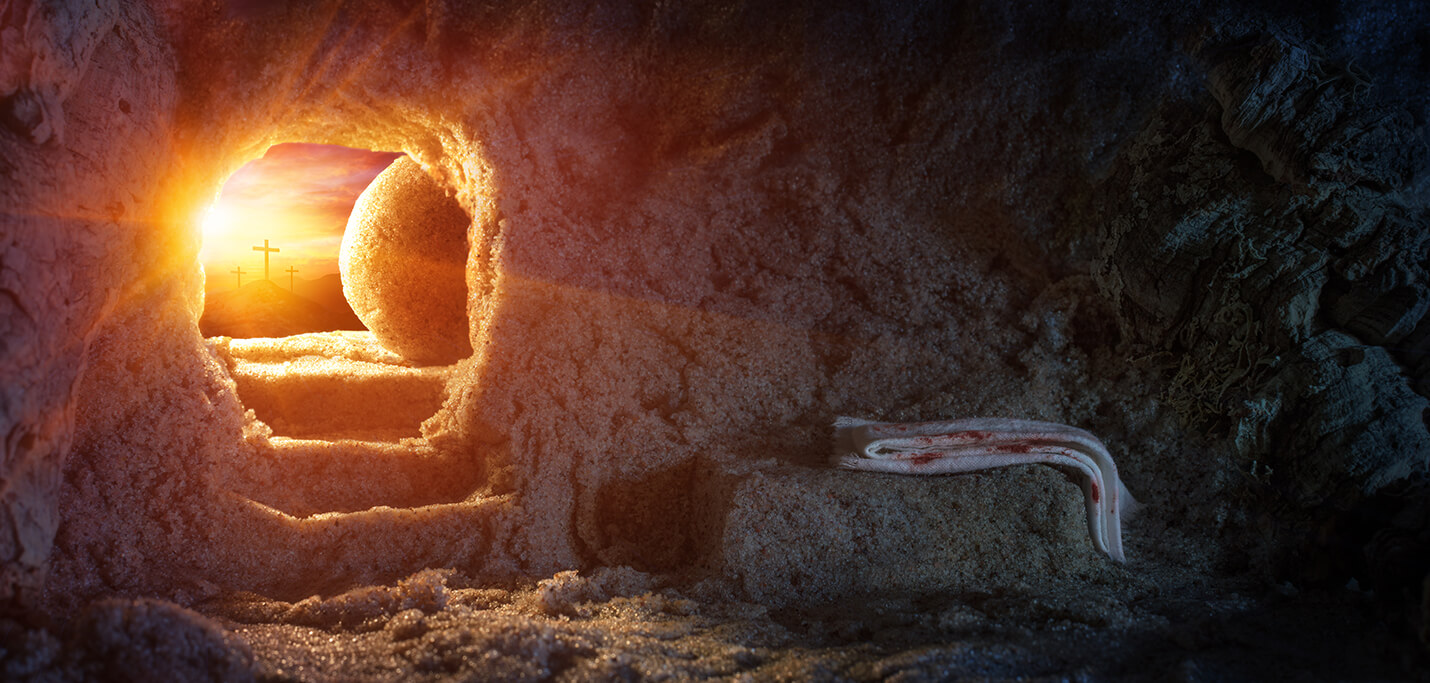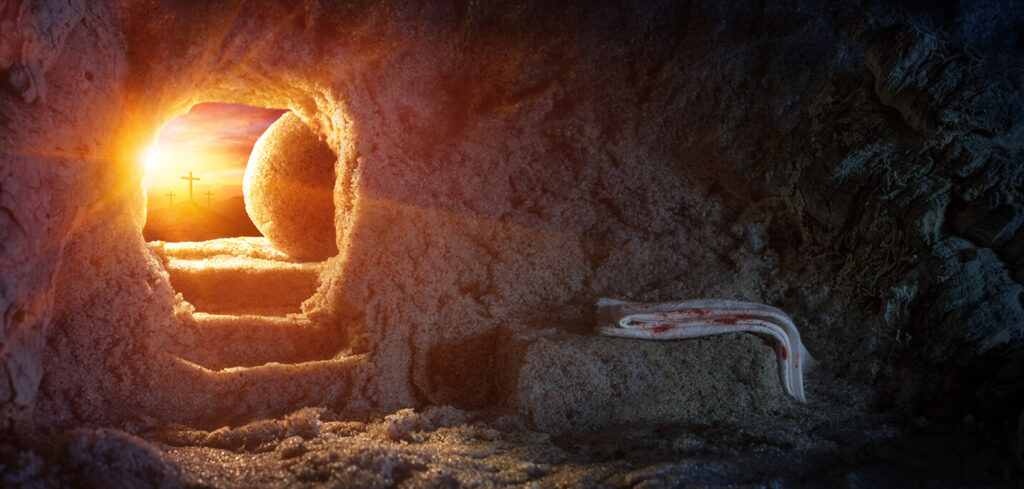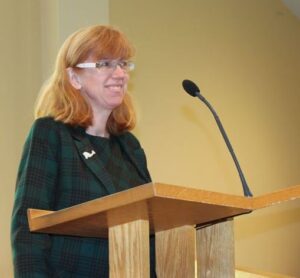Christ is risen. He is risen indeed.
I always love this joyful affirmation of life and hope on Easter morning. When it is still grey and cold outside, when the world news is so overwhelmingly negative, when many are dealing with losses and heartache, it is so amazing to be able to say: “Christ is risen. He is risen indeed.”
This is the joyful centre of our faith, that God was, is, and is yet to come, and we are a part of this story that is not just a story. Even in—and maybe especially in—our dark places, God is. We have a faith identity that joyfully lives forward into each day, knowing that God is life anew. Hope instead of fear. Light instead of darkness. Love instead of hate. It is such a needed message for individuals and the world.
I wish we believed it.
I know that doesn’t sound quite right because people come to church on Easter morning. Of course, we believe in the resurrection, don’t we? We hear the story, we say the words, we try to follow Jesus’ teachings, and we live in hope that someday there will be salvation, reconciliation, life after death, the lion with the lamb.
Like Mary, Peter and the beloved disciple, we bring our questions with us on Easter morning. But if Christians all around the world truly and deeply believe that when that stone was rolled away, Jesus is alive, wouldn’t it change things? Wouldn’t there be a tremendous energy unleashed in us, a passion for loving each other that would overcome selfishness, a relief from the pain of loss, a lack of fear of death, an utter joy in the absolute knowledge that God is there always?
So why, then, if we are believers, do we struggle with fear of death, wars, greed, petty theological arguments, brokenness, addictions and the darkness of the soul?
Christ is risen, he is risen indeed. Perhaps sometimes we aren’t able to say this so enthusiastically. But that is part of the original story, too. The disciples, that first morning when confronted by an impossibly empty tomb, were not uniformly joyful.
Mary is the main character in John’s story of the empty tomb. She is emotionally distraught, so she shows up alone, in the dark . . . and finds it open. This sounds awful, creepy even, like the set-up to a horror movie or a Buffy the Vampire Slayer episode. We wonder what might come out of that empty place.
Mary doesn’t immediately celebrate either. She doesn’t proclaim resurrection when she first sees the open tomb. She also doesn’t panic but does the practical thing. She assumes there has been a robbery or that the Romans have taken the body. She doesn’t go into the tomb; after all, if there are robbers, they might still be there. Plus, a tomb is a scary place; no one wants to be around a dead body, especially a few days old.
So she runs to tell the upsetting news to the disciples. Peter and the other disciple run back to the tomb, followed by Mary. Peter goes in first. He sees the grave clothes. The cloth that had covered Jesus’ face was neatly folded and set to the side, which is strange. Grave robbers would not have bothered with making things neat; they were only interested in valuables and would have left the body. If Roman soldiers had taken Jesus, they would not have unwrapped him. Nothing here makes sense, and there is no indication from Peter that he believes Jesus has risen.
Because faith comes a bit slowly for Peter. He is emotionally wrung out, completely numb from the last week: the trial, his denials of Jesus, the crucifixion, the hiding. Peter needs time, he needs to see more and talk with the others.
For the other disciple mentioned in John 20, faith comes quickly. In verse 8 it says he “went in; he saw and he believed.”
After they see the empty tomb, Peter and this other disciple return to their homes. That’s it. The story is a let down here. Why aren’t they running home? Why isn’t Peter yelling about robbers or Romans, or something? Why isn’t the disciple who believed shouting out “He is risen”? I think they are still confused, mystified, at a loss for what to do.
And Mary, she stays behind, alone again and weeping. Now, she is able to get close enough to the tomb to look for herself. She is overwhelmed with grief. Her reaction is so understandable for people who have lost a loved one. She is drawn to the tomb because she wants to be close to him, unable to go back to her home and try to live normally.
This time of grief is important. It is important for Mary not to jump too quickly to the joy she will eventually find. Many of us have felt this way right after the funeral of a loved one. It’s hard to go home, to do regular things, to move on. It’s painful to hear people say things like “they are in a better place,” as if we are somehow wrong to feel the grief and pain, and we should move on immediately.
In the March 2016 issue of Christianity Today, columnist Courtney Reissig writes: “Knowing the joy of the resurrection requires us to acknowledge the pain of death.” She encourages people to not ignore their pain or to try to minimize their loss. She questions the trend toward happy funerals that minimize the loss of the deceased, saying, “a joyful focus on the resurrection—and the push to celebrate—can overshadow the truth about death. . . . [I]n order to know the good news of Easter, we have to endure Good Friday and Holy Saturday first. We know the truth, but still we feel the pain.”
Mary feels the pain keenly. She is so distraught that angels do not frighten her; she just answers them with grief. Even when she looks right at Jesus—through tears she does not recognize him—she just goes on in her grief, asking if this “gardener” knows where the body is.
This is one of the most moving encounter stories I can think of. When Jesus tenderly calls Mary away from her tears to recognition, I am reminded of the assuring words from Isaiah 43: “Fear not, for I have redeemed you; I have called you by name, you are mine.”
The Christmas story is full of angels and fear nots, but now, at Easter, when we seem to need them most, we have none. Well, we have two angels, but they just ask an obvious question: “Why are you weeping?” Well, duh!
Reissig writes: “As Christians, the older we get the more we sense the need to hold this tension [between grief and joy] more fully. As we watch loved ones die, mourn with friends who lose beloved family members, and face the ever-present reality of aging in our own bodies, we know that this life is coming to a swift end day by day. We can grieve over this, while also recognizing the hope of a resurrected body for all of us who cling to the Jesus who perfectly did both. This same Jesus who wept over the reality of death sent blood rushing back through the cold veins of his dead friend [Lazarus]—and promises to give us new life too. Death is imminent, but Sunday is coming.”
Understanding is so hard. But this is the crux of the story. When you meet Jesus at the empty tomb through the story you’ve heard over so many Easters, how do you understand?
This year, in the huge overarching sense, I know that God is God, and that life is not confined to my limited and incomplete experience. It continues somehow, with God, in rich relationships after this world is finished. But here, today, resurrection means something else, too; it means something for how we keep on living, moving forward in the face of difficulty and death.
Those days when we feel wrung out, demeaned, depressed or destroyed, there is hope. In those soul-destroying times, sometimes we will hear Jesus softly speak our name. We may not go back to the way things were, but looking at an empty tomb on Easter morning starts hope growing. We draw hope that maybe our experiences of grief and loss are not complete endings. There is a beginning of a new and great hope for life that will not end in grief but in joy.
All levels of belief—or lack of it—are present in our churches and the world on Easter morning, and they hear the proclamation, “He is risen indeed.”
Just like Peter, some need to hear more, experience more. May hope be unleashed by this story of the stone rolled away.
For those who joyfully and easily believe, may courage and proclamation be unleashed in you.
For those who, like Mary, are paralyzed by grief, may you hear your name spoken softly in words of love so that you may find comfort, so that you may move on reassured and looking forward to joy.
For the disciples who came to the tomb and found it empty, their witness to what they experienced birthed the church, which spread like wildfire with wild hope in new life.
If we come to believe deeply and truly that Jesus is alive, what does this rolled-away stone unleash in us? What hope, what love, what change will be unleashed in us for this hurting world?
Based on a sermon Donita Wiebe Neufeld preached on Easter Sunday, March 27, 2016, at First Mennonite Church in Edmonton
See additional resources at www.commonword.ca/go/504
For discussion
1. What are the sources of joy in your life? What are some ways that Christ’s resurrection brings hope, light and love to the church? In light of the resurrection, how do you explain our continuing struggle with the “fear of death, wars, greed, petty theological arguments, brokenness, addictions and the darkness of the soul”?
2. Donita Wiebe-Neufeld writes that, like Mary and Peter, “we bring our questions with us on Easter morning.” What are your questions as you ponder the Easter message? What does it mean to hold together the tension between grief and joy?
3. Can you think of a difficult time when you heard Jesus softly speak your name? What are some ways that we can regularly remind ourselves of the hope and joy that comes with the Easter message? How important is it to set aside a regular time for worship?
4. Wiebe-Neufeld asks, “If we come to believe deeply and truly that Jesus is alive, what does this rolled-away stone unleash in us?” Can you think of some new ways for the church to pass on the resurrection message of hope to the world?
—By Barb Draper









Leave a Reply
You must be logged in to post a comment.